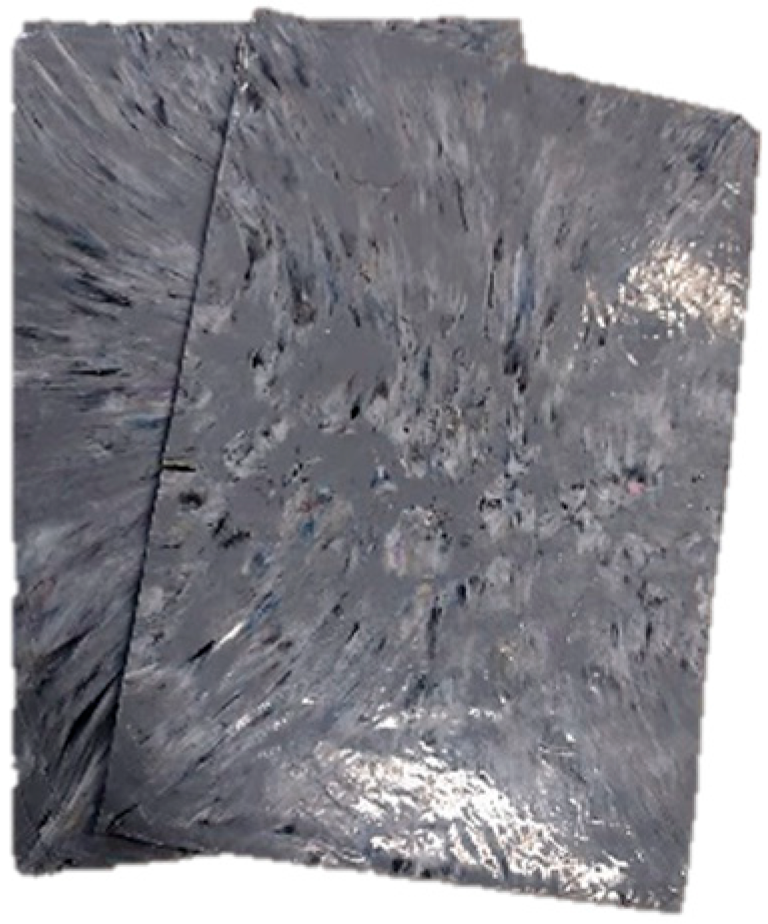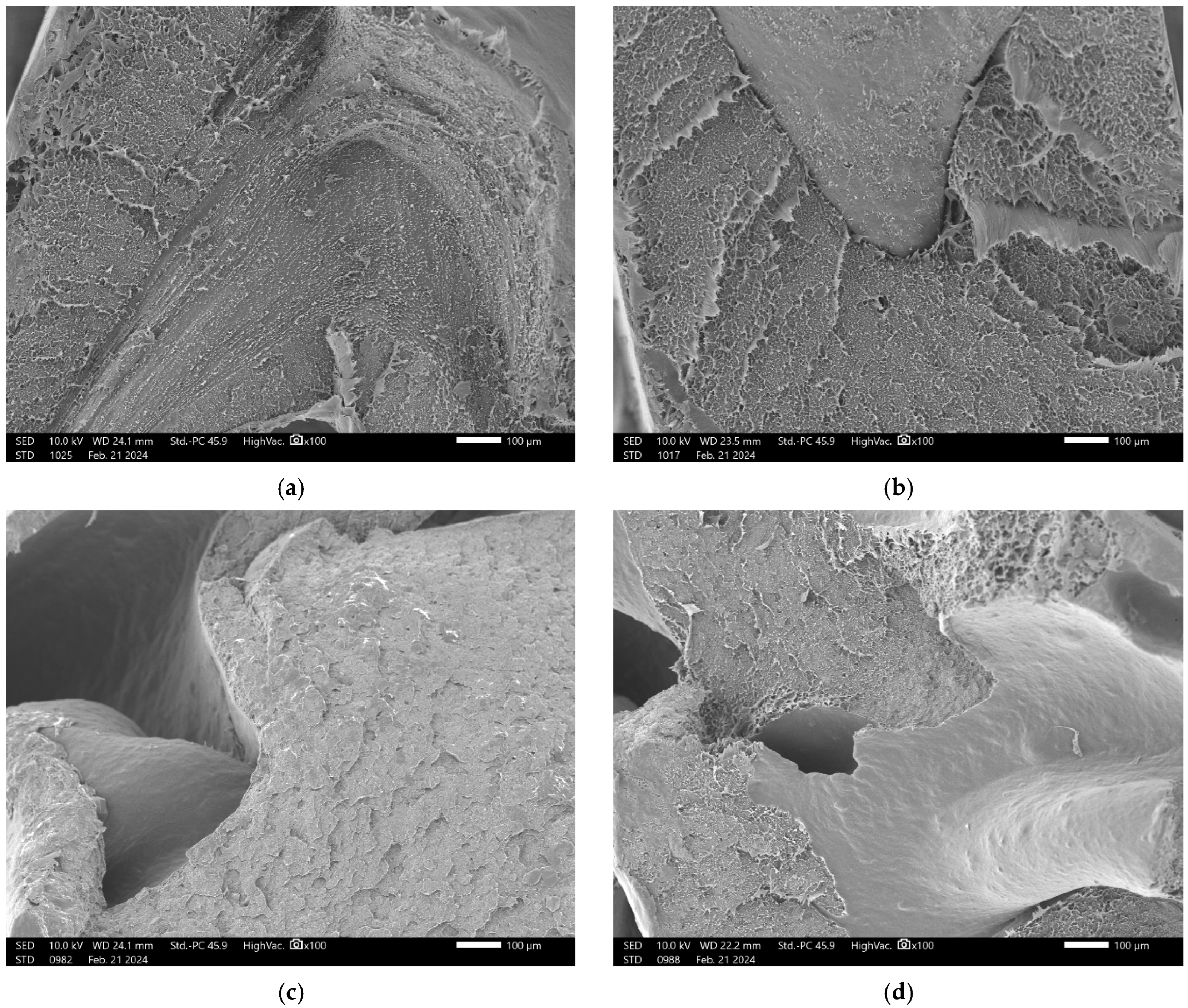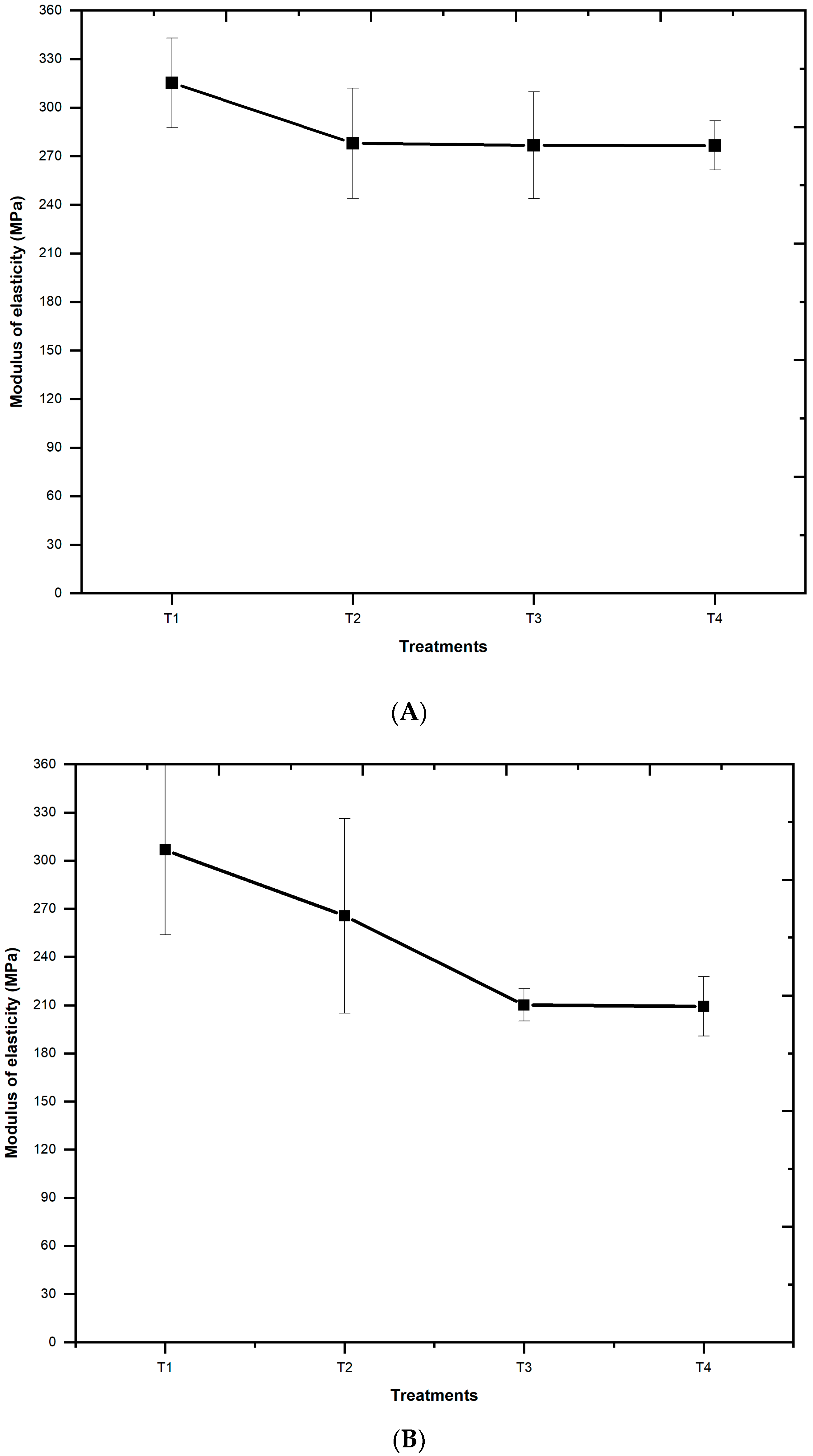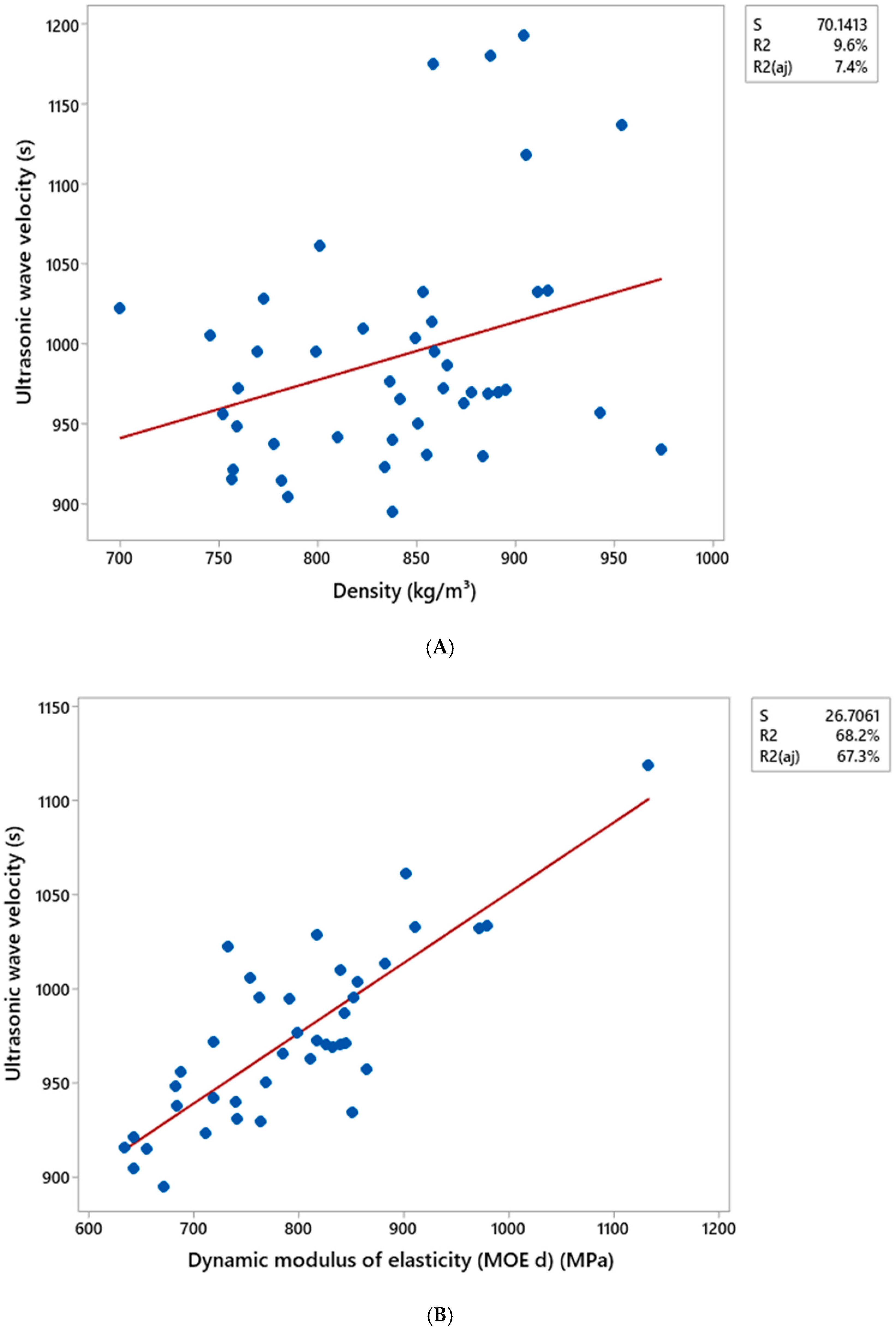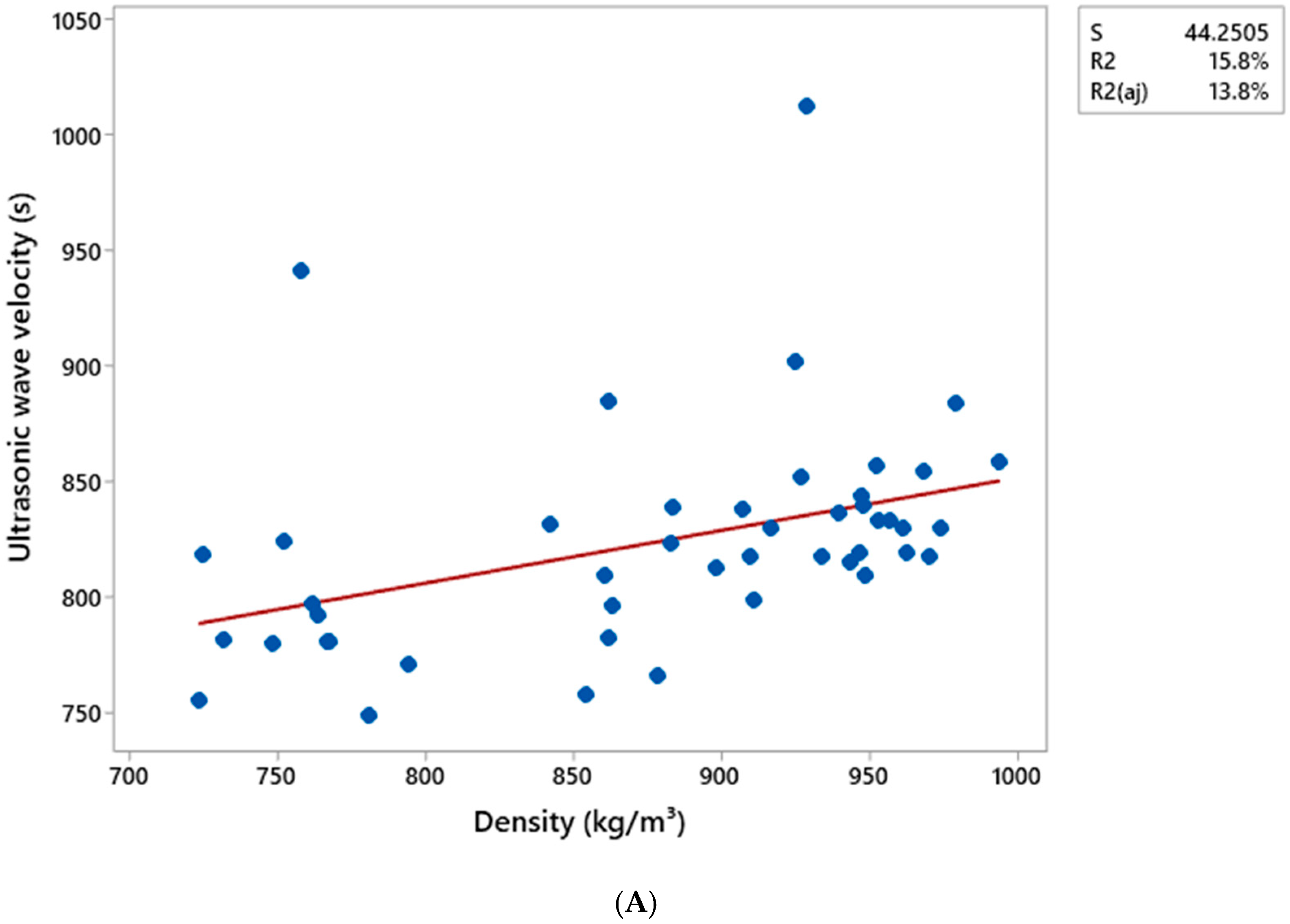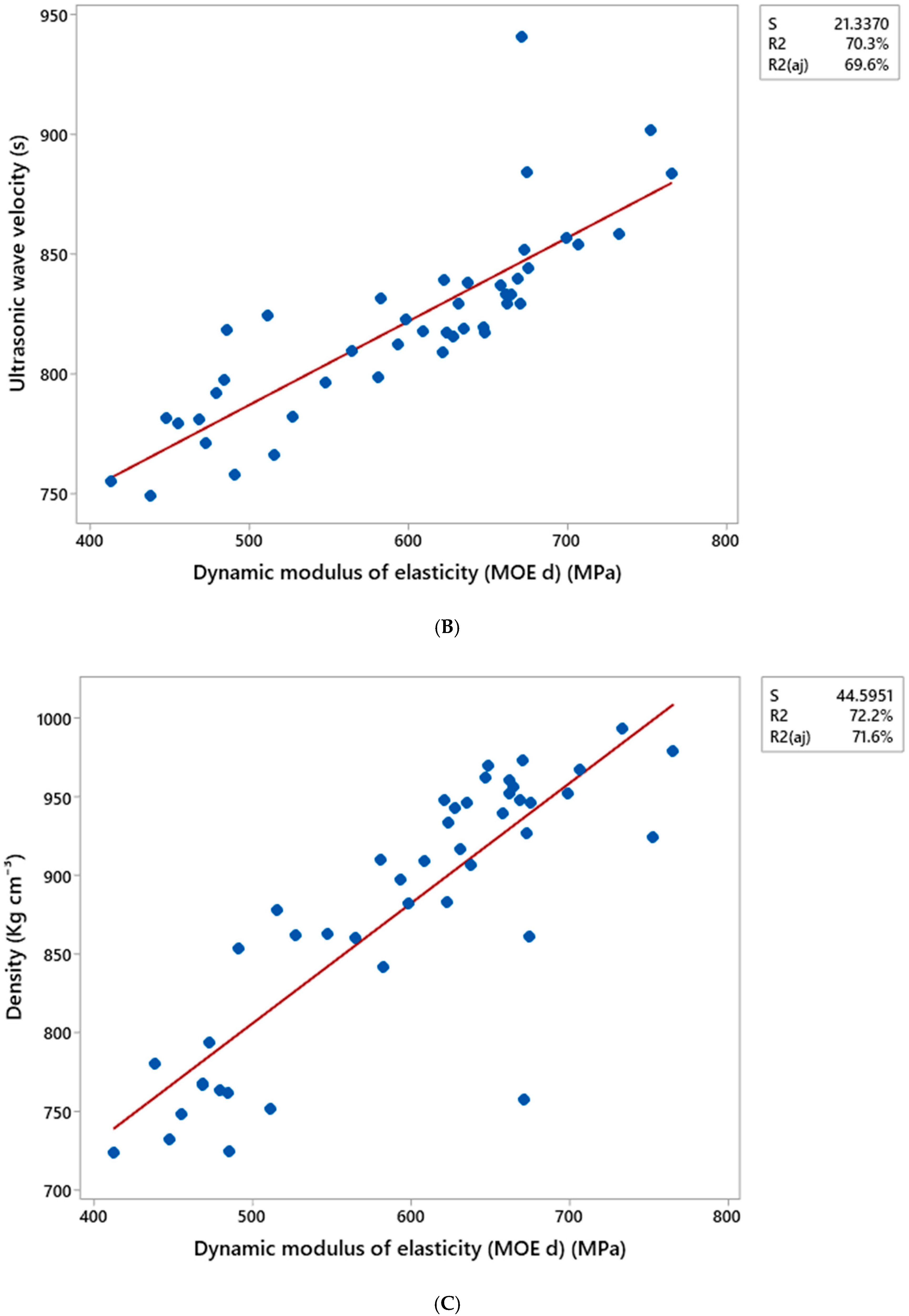3. Results and Discussion
Figure 4 presents micrographs of the fracture region of composites containing different proportions of charcoal fines, produced by the extrusion method, obtained at 100× magnification. Micrographs A, B, C, and D correspond to treatments with 0, 5, 10, and 15% charcoal particles, respectively.
It can be observed that with the increasing addition of charcoal particles (
Figure 4c,d), there is a non-uniform distribution of the particles within the high-density polyethylene (HDPE) matrix. This behavior is evidenced by the striated and rough morphology, with deep valleys and some coarse ridges, where the stretching of the plastic material becomes clearly visible.
The particle pull-out, highlighted by red circles, indicates the presence of a weak filler–matrix interface, which limits the mechanical performance of the composite. The evidence of particle detachment suggests that the adhesion at the interface was insufficient to withstand the stresses generated during fracture, which may impact the reduction of the tensile strength and the modulus of elasticity (MOE) of the composites.
This weak interface compromises the efficiency of the material reinforcement. Previous studies, such as [
21], indicate that smaller particles tend to enhance the interaction between the matrix and the reinforcement. However, this effect was not observed in the present study, possibly due to the broad particle size distribution (0.425 mm > 0.250 mm) and the high particle concentration in the analyzed treatment.
The physical interpenetration of the particles with the matrix, as evidenced by the observed detachment, suggests the need to improve interfacial adhesion in these composites. The incorporation of coupling agents could be an effective strategy to strengthen the interface and enhance the performance of the composites.
A coupling agent is a chemical compound that acts at the interface to create a chemical bridge between the reinforcement and the matrix. It improves interfacial adhesion when one end of the molecule anchors to the reinforcement surface, while the functional group at the other end reacts with the polymeric phase [
22].
Figure 5 presents micrographs of the fractures of composites containing 0%, 5%, 10%, and 15% charcoal fines, obtained at 20× magnification, of the composites produced by pressing. Image a shows the micrograph of the fracture in the absence of charcoal fines. A smooth surface is observed, characterized by the absence of visible cracks or irregularities. Images b, c, and d, corresponding to treatments T2, T3, and T4, containing 5%, 10%, and 15% fines, respectively, highlight an increase in the presence of voids (marked by red circles) as the concentration of charcoal fines increases, regardless of the manufacturing method employed.
According to Marinelli et al. [
23], the presence of voids in the polymeric matrix, in concentrations exceeding 20% of the total volume, significantly compromises the mechanical properties of composite materials. The reduction in maximum stress and the modulus of elasticity (MOE) observed in composites with higher fine charcoal content suggests that the formation of voids may have been the determining factor for this decrease.
From the tensile test, it was possible to obtain the results for maximum stress, modulus of elasticity (MOE), and rupture strain of the composites manufactured by pressing and extrusion methods, and with different percentages of incorporation of charcoal particulate.
The obtained results allowed for the evaluation of the applicability of the composites based on their mechanical properties.
The comparison between the production methods (pressing and extrusion), conducted through analysis of variance followed by the Tukey test (
p < 0.05), did not identify statistically significant differences in the maximum tensile stress of the composites, as presented in
Table 2.
On the other hand, the variation in the proportion of charcoal particulate significantly influenced the maximum stress, as shown in the data presented in
Table 3.
The application of the Tukey test revealed that the treatment composed solely of HDPE, subjected to the pressing process, exhibited significantly different averages when compared to the other treatments that included the incorporation of particulate. However, for the composites produced by extrusion, the test did not detect statistical differences between treatments 1 and 2 (which contained 0% and 5% charcoal particulate, respectively), nor between treatments 2, 3, and 4 (which contained 5%, 10%, and 15% charcoal particulate, respectively).
The tensile test revealed that the composite made exclusively from high-density polyethylene (HDPE), without the incorporation of coal particulate, exhibited a maximum rupture stress 19% higher when manufactured by the pressing method compared to extrusion processing. When comparing these results with the reference values for HDPE, reported by Peacock [
24], Mulinari et al. [
25], and Saleh et al. [
26], which range from 34 to 16.7 MPa, it is observed that the values obtained in this study fall within the expected range.
The incorporation of coal particulate into the composites resulted in a reduction in the maximum stress observed, regardless of the processing method used (pressing or extrusion). In the composites manufactured by pressing, the maximum stress decreased by approximately 50% when comparing treatment 1 (100% HDPE) with treatment 4 (85% HDPE and 15% coal particulate). On the other hand, in the composites obtained by extrusion, the reduction in maximum stress was around 43%.
As evidenced by Rosa [
27], the tensile strength analyses demonstrated that the addition of biomass from acai peel to high-density polyethylene (HDPE) resulted in a significant reduction in mechanical properties, particularly in maximum stress, when compared to pure HDPE.
The statistical analysis of the elasticity moduli of the composites, using Tukey’s test, indicated a significant difference between the pressing and extrusion manufacturing methods (
Table 4).
The values of the static modulus of elasticity (MOE) of the composites produced by the pressing method showed a marginal increase compared to those produced by the extrusion method. In treatments without the incorporation of fine particles, the composites obtained by pressing achieved a static MOE of 315.26 MPa, representing an increase of approximately 2.7% compared to the composites manufactured by extrusion, which recorded an MOE of 306.6 MPa (
Table 5).
Although exhibiting a lower modulus of elasticity (MOE) compared to the composites made by pressing, the composites obtained by extrusion displayed a higher standard deviation among the analyzed samples.
In relation to the incorporation of coal particulate, it was found that the static modulus of elasticity (MOE) exhibited behavior similar to that observed for the maximum stress, as determined in the tensile test. Both variables did not show statistically significant differences between the treatments that included reinforcement with coal particulate. Furthermore, a trend of reduction in the values of these variables was observed as the percentage of added particulate increased.
Table 5 demonstrates that the increase in the concentration of charcoal particulate in the composites is correlated with a significant reduction in the modulus of elasticity. The incorporation of 15% charcoal particulate resulted in a 12.3% reduction in the modulus of elasticity for the composites produced by the pressing method and a 31.8% reduction for those obtained through extrusion, compared to pure high-density polyethylene (HDPE) without the addition of particulate. These results show that the addition of charcoal particulate compromises the material’s ability to withstand deformation before fracture, leading to a degradation of the mechanical properties.
The modulus of elasticity values was analyzed through graphs to assess the trend of variation as a function of the different additions of charcoal particulate to the HDPE matrix. The outcome of this analysis is presented in
Figure 6.
The results obtained in this study corroborate the findings of Melo [
25], which demonstrated that the addition of shell powder particles to high-density polyethylene (HDPE) composites leads to a significant reduction in the modulus of elasticity. Melo [
28] determined the modulus of elasticity of pure HDPE to be 560.91 ± 1.70 MPa.
Ayadi et al. [
29] investigated HDPE composites reinforced with rice husk biochar and wood flour. The authors observed that the biochar obtained through rapid pyrolysis at temperatures above 400 °C reduced the mechanical properties of the composites. This difference was attributed to the distinct chemical compositions and surface structures of the reinforcements analyzed.
Studies by Das et al. [
30] and Khan et al. [
31] highlighted a non-linear relationship between the tensile strength of composites and the concentration of biochar. Beyond a specific threshold, increases in biochar concentration significantly reduced tensile strength, accompanied by a transition in the matrix behavior from ductile to brittle. This behavior was attributed to particle stacking and polymer matrix crosslinking at high biochar concentrations, which promote brittleness and reduce the material’s load-bearing capacity.
Additionally, a concomitant reduction in tensile strength and percentage elongation was observed with increasing biochar concentration. These results indicate that the composite’s stiffness increases as its ductility decreases, underscoring the need to determine an optimal biochar concentration to balance these properties [
8]. Such behavior is often associated with factors like the formation of interfacial voids and the disruption of polymer matrix continuity.
Awad et al. [
32] emphasized that the mechanical performance of HDPE composites reinforced with particles is influenced by parameters such as particle size, the matrix-reinforcement interface, and particle dispersion. The interface plays a crucial role in load transfer between the matrix and reinforcement, directly affecting the composites’ strength and toughness [
33]. However, at high particle concentrations, agglomeration occurs, hindering uniform distribution and compromising the efficiency of the interface.
The strength of composites is determined by the critical fracture path. While hard particles can concentrate local stresses and promote crack initiation [
34], they can also act as barriers to fracture propagation, thereby increasing toughness [
35].
In the context of polyester composites reinforced with charcoal particles, Akaluzia et al. [
12] reported that an increase in reinforcement content led to insufficient interfacial adhesion, favoring the formation of microcracks and reducing resistance to crack propagation. This behavior was attributed to stress concentration and the formation of structural voids, which decreased the energy required for fracture.
Dalpiaz [
36] demonstrated that particle size directly affects the tensile strength of composites. As particle diameter decreases, the surface area increases, enhancing matrix-reinforcement interaction and reducing stress concentrations. This effect results in higher tensile strength.
The observed reduction in mechanical properties in this study can be explained by the low efficiency of stress transfer between the matrix and the particles, likely due to inadequate interfacial interaction. Fu et al. [
34] emphasized that in systems with weak interfacial adhesion, discontinuities caused by delamination significantly reduce load transfer. In contrast, well-bonded interfaces promote synergy between matrix and reinforcement, increasing composite strength.
Zhao et al. [
37] highlighted that reducing particle size increases the particle–matrix interfacial area, promoting better load transfer and higher strength. This effect is more pronounced for larger particles, suggesting the existence of a critical size below which further reductions in size have a limited impact on the mechanical properties of the composite.
Another explanation for this type of behavior can be attributed to the physical characterization of the composite. The addition of particulate to the matrix may have led to an increase in the porosity of the material, resulting in composites with more defects and imperfections. As a consequence, the material’s strength is reduced.
In their study, Das et al. [
38] observed that the addition of more than 4% by weight of coal filler to polyester composites resulted in a reduction of mechanical properties, characterized by a decrease in strength. The authors attributed this decrease to the aggregation of coal particles in the polymer matrix, which hinders stress transfer and the formation of a complex interpenetrating network, which can act as a crack initiator.
Although the composites exhibited a reduction in mechanical properties, it is important to consider that other characteristics, beyond mechanical strength, may be relevant for specific applications. The performance of composites is multifaceted and depends on the particular application. The reduction in mechanical properties does not rule out the use of these materials in components where the design can compensate for this limitation by exploiting other features such as lightness, thermal insulation, or chemical resistance.
The results obtained from the excitation wave propagation test demonstrate the influence of the coal particulate content and the production method on the dynamic modulus of elasticity (MOE d). The statistical analysis, conducted using the Tukey test, revealed no significant differences in the dynamic modulus of elasticity (MOE d) between the pressing and extrusion production methods (
Table 6), which contrasts with the findings for the static modulus of elasticity (MOE e) assessed in the tensile test.
The statistical analysis, using the Tukey test, demonstrated that the coal particulate content exerts a significant influence on the dynamic modulus of elasticity (MOE d) of the composites (
Table 7). Treatments 3 and 4, corresponding to 10% and 15% particulate, respectively, showed no statistically significant differences, aligning with the results observed for the static modulus of elasticity (MOE e).
The results demonstrated that the composite without the incorporation of charcoal particulate exhibited the highest dynamic elastic modulus (MOE d). The progressive addition of charcoal particulate to the polymer matrix promoted a systematic reduction in MOE, a behavior also observed in the tensile test.
The decrease in mechanical strength observed with the increased addition of charcoal reinforcement can be attributed to the reduction in the interfacial area between the matrix and the filler. The increase in the concentration of reinforcement particles restricts the polymer matrix’s ability to diffuse and efficiently adhere to each particle, compromising load transfer and, consequently, the mechanical properties of the composite [
32].
The dispersion of particles in the matrix significantly influences the composite’s elastic modulus, as highlighted by Lins [
39]. According to the author, uniform dispersion increases the interfacial contact area, favoring load transfer and, consequently, the modulus. The decrease in the observed dynamic elastic modulus can be explained by the presence of particle clusters or weak adhesion between the matrix and the reinforcement, both of which compromise load transfer and reduce the modulus.
The low interfacial adhesion, possibly attributed to incompatibility between the components, limited chemical interaction, or the formation of pores and voids resulting from the presence of the reinforcement, may have been a critical factor in the observed property reduction. Previous studies [
40,
41] suggest that the application of coupling agents or surface modification of the particles are effective strategies to improve interfacial adhesion and, consequently, the properties of composites.
A similar finding was reported by Pauleski et al. [
42], who investigated the feasibility of using rice husk and wood particles in the manufacture of composites, utilizing high-density polyethylene (HDPE) as a binder. The results demonstrated that, with the decrease in the percentage of rice husk in the mixture, the values of the elastic modulus (MOE) increased, regardless of the proportion of HDPE used.
During their wave propagation, waves interact with the heterogeneities of the structure, such as interfaces between distinct materials, defects (voids, cracks, delaminations), geometric variations (holes, reinforcements), and boundaries with the external environment. These interactions result in phenomena such as reflection, refraction, diffraction, and attenuation of the incident wave, depending on the material properties and the geometry of the discontinuity [
43].
One of the objectives of the ultrasonic wave propagation test, performed using an ultrasonic device, is to generate different types of waves in a specific material, analyzing its structural characteristics and detecting defects based on how each type of wave propagates [
44,
45].
The average values of density, ultrasonic wave propagation velocity, and dynamic modulus of elasticity (MOE d) determined through the ultrasound test are presented in
Table 8. Data analysis revealed that the production methods of pressing and extrusion exhibited statistically significant differences in the variables of ultrasonic wave velocity and dynamic modulus of elasticity (MOE d), while no significant difference was observed for the density variable.
To analyze the incorporation of particulate,
Table 9 shows that the addition of these materials caused significant changes in density properties and dynamic modulus of elasticity (MOE d). A trend of reduction in dynamic MOE, density, and ultrasonic wave velocity of the composites was observed as the proportion of added coal particulate increased.
The average density values observed for the treatment without the addition of particulate were 875.5 kg/m3 for the composites obtained by pressing and 929.3 kg/m3 for those produced by extrusion. The incorporation of particulate resulted in a reduction of approximately 5% in the density of the composites produced by pressing and around 19% in those produced by extrusion.
The dynamic modulus of elasticity (MOE d) did not show significant differences between the composites manufactured by pressing with the addition of particulate. For the composites produced by extrusion, it was observed that treatments 3 and 4, containing 10% and 15% coal particulate, respectively, showed no statistically significant differences between them. These results were consistent for both the elasticity moduli obtained by tensile testing and those determined by wave propagation excitation tests.
In accordance with the findings of this study, Karmarkar et al. [
46], in a comparative analysis of the dynamic and static elasticity moduli of HDPE composites reinforced with natural fibers, reported that as the fiber content increased, the ratio between the dynamic modulus and the tensile modulus significantly decreased. This reduction was attributed to the stiffening of the polymer by the incorporated fibers.
It was also observed that the values of the dynamic elasticity modulus obtained through ultrasound were higher than those of the static modulus determined by tensile tests. This difference, also reported in other studies [
47,
48], can be attributed to the viscoelastic behavior of the material. The composites exhibit both elastic and viscous deformations simultaneously, leading to an overestimation of the dynamic modulus relative to the static modulus, as highlighted by Borůvka et al. [
49].
Table 10 and
Table 11 present the Pearson correlation matrix, indicating the correlation coefficients and their respective significance values (
p-values) for all the variables analyzed based on data obtained from ultrasonic wave propagation tests conducted via pressing and extrusion methods, respectively. The results for the composites produced by the pressing method revealed correlation coefficients of 0.310, 0.660, and 0.826 for the combinations of Ultrasonic Wave Velocity (UWV) × Density (
), Modulus of Elasticity (MOE) × Density (
), and Modulus of Elasticity (MOE) × Ultrasonic Wave Velocity (UWV), respectively.
The composites produced by the extrusion method revealed correlation coefficients of 0.397, 0.850, and 0.839 for the combinations of Ultrasonic Wave Speed (UWS) × Density (), Modulus of Elasticity (MOE) × Density (), and Modulus of Elasticity (MOE) × Ultrasonic Wave Speed (UWS), respectively.
These results indicate the presence of strong positive and statistically significant correlations between the variables, suggesting the existence of a direct linear association between them. This means that as one variable increases, the others tend to increase as well. The upper diagonal represents the significance values. The lower diagonal represents the obtained values.
The results of this study are in accordance with those found by Nogueira and Willan [
50], who established a direct relationship between the propagation speed of ultrasonic waves and mechanical properties such as elastic modulus, Poisson’s ratio, and material density. These authors emphasized that, although these properties are not directly linked to the material’s strength, they significantly influence wave propagation within the composite medium.
The introduction of coal particles into the matrix may result in an increase in the material’s porosity. This increase in porosity, in turn, may lead to a decrease in the composite’s density, negatively impacting the propagation of ultrasonic waves. The presence of pores acts as structural defects, scattering and attenuating the ultrasonic waves, which results in a reduction in propagation speed. The lower density of the porous material reduces the resistance to wave propagation, facilitating their transmission.
These results are consistent with studies by Toyama et al. [
51] and Mardanshahi et al. [
52], who also identified that matrix cracking and the consequent damage caused decreased the stiffness of the composites, leading to a reduction in wave propagation speed.
Figure 7 and
Figure 8 display the scatter plots for the combinations between the variable’s density (kg cm
−3), ultrasonic wave speed (s), and elastic modulus (MPa), along with their respective coefficients of determination (R
2). The letters A, B, and C represent the relationships between ultrasonic wave speed and density, ultrasonic wave speed and elastic modulus, and density and elastic modulus, respectively.
The correlations between ultrasonic wave speed and elastic modulus, as well as between density and elastic modulus, exhibited higher coefficients of determination (R2). For the composites manufactured by pressing, the R2 values were 68.2% and 43.5%, respectively, while for those produced by extrusion, the values were 70.3% and 72.2%.
These results are consistent with the Pearson correlation matrix, in which the relationship between ultrasonic wave velocity and density exhibited a lower correlation coefficient compared to the other relationships, also reflecting a lower R2 value.

